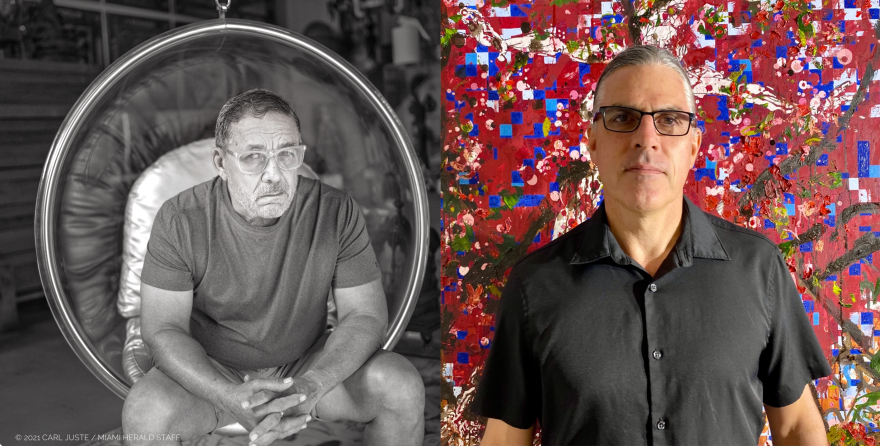Two prominent South Florida artists are attempting to view history and the mundane of life through a different perspective explored in their colorful work.
On the March 29 episode of Sundial, artists John William Bailly and Edouard Duval-Carrié joined us to talk about The Miami Creative Movement exhibit at The Center for Visual Communication in Wynwood.
It is highlighting the work of 15 of Miami's leading artists.

Bailly has lived and worked in Miami for more than 40 years. But when he creates art, he tries to see the place like an outsider.
He’s an artist-in-residence at the Deering Estate, near Cutler Bay. One of the ways he creates art is by hiking into the hardwood forest surrounding the property for inspiration. It’s the kind of place you can take for granted when you live in a big city.
For one piece, Bailly painted the Tequesta burial mound on the property. He tried to envision it as it might’ve been thousands of years ago.
He tries to see a place with fresh eyes and paint from there in an attempt to help others find a new perspective.
His painting exhibited at The Center for Visual Communication is titled "Francisco and Diego" — named after Don Diego, a Tequesta man, and Francisco Villarreal, a Jesuit.
Bailly shared that in his research for his artwork, he was able to obtain the oldest existing copy of a letter written in Miami on January 29, 1568, by Villarreal — where he writes about mosquitos, celebrating mass and more.
Access to this extraordinary piece of history started with a cold email to The Society of Jesuits in Rome. He shared the full story on Sundial. See a copy of the letter here.
Bailly also teaches a class at FIU that treats Miami like a study abroad program. So students who live here can see Miami in a new way.
He has a new film that follows his creative process, from hiking in the mangroves and researching early Miami history. It premieres at the Deering Estate on Sunday, April 16. Find more information here.

For Edouard Duval-Carrié, returning to Haiti as a teenager awakened him to examine his own history.
His family fled Haiti for Puerto Rico when he was a kid. It was the early years of Haiti dictator François Duvalier, also known as "Papa Doc."
Moving back to his birth country was a shock, says Duval-Carrié, who was fascinated by Haitian history and culture and religion because he realized he didn’t understand it.
Duval-Carrié says he still doesn’t.
He tries to make sense of it through his art. His paintings mix religious icons with Haitian mythology and history. They’re playful and surreal.
On Sundial's previous episode, Hanif Abdurraqib, an award-winning poet, essayist and journalist. He told us about his obsession with sneakers, daily rituals he revels in, the music that formed him as the youngest of four siblings.
Listen to Sundial Monday through Thursday on WLRN, 91.3 FM, live at 1 p.m., rebroadcast at 8 p.m. Missed a show? Find every episode of Sundial on your favorite podcast app, such as Apple Podcasts, Stitcher and Spotify.
Stay in touch with us by emailing us at sundial@wlrnnews.org.





